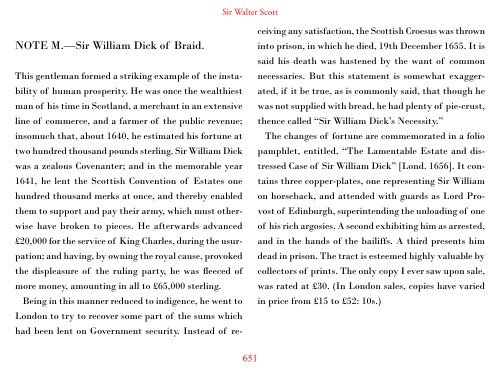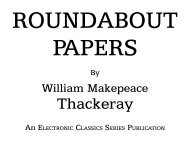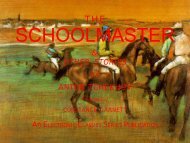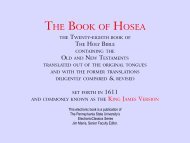- Page 1 and 2:
THE HEART OF MID-LOTHIAN By Walter
- Page 3 and 4:
Sir Walter Scott, 1st Baronet (15 A
- Page 5 and 6:
THE HEART OF Sir Walter Scott 5 MID
- Page 7 and 8:
“The Heart of Mid-Lothian,” in
- Page 9 and 10:
censure of these industrious litera
- Page 11 and 12:
was given to many children, in piou
- Page 13 and 14:
There’s a bloodhound ranging Tinw
- Page 15 and 16:
of it.” “I do not think that th
- Page 17 and 18:
part of its remarks. The Reviewer f
- Page 19 and 20:
may meet with a purchaser: unless (
- Page 21 and 22:
with impartiality. For, O ye powers
- Page 23 and 24:
disengaged countenance. She said,
- Page 25 and 26:
ney to London, but found this nearl
- Page 27 and 28:
part of a century, uniformly acknow
- Page 29 and 30:
colouring. But that which gratifies
- Page 31 and 32:
newspapers, having succeeded in dis
- Page 33 and 34:
“O, true, Mr. Dunover,” said on
- Page 35 and 36:
“Poor man!” echoed Halkit—
- Page 37 and 38:
secret view to my present task),
- Page 39 and 40:
etween indignation at the undeserve
- Page 41 and 42:
monarch, who, after having commence
- Page 43 and 44:
tence. During a brief gleam of hope
- Page 45 and 46:
THE HEART OF MIDLOTHIAN CHAPTER FIR
- Page 47 and 48:
victed was of a description calcula
- Page 49 and 50:
judged necessary; and such was the
- Page 51 and 52:
ceived their meaning, or whose thou
- Page 53 and 54:
sent him to serve in the corps long
- Page 55 and 56:
and a hook at the back of the hatch
- Page 57 and 58:
who favoured him. These internal em
- Page 59 and 60:
He sprung from the scaffold, snatch
- Page 61 and 62:
CHAPTER THIRD “The hour’s come,
- Page 63 and 64:
tive for which those under whose au
- Page 65 and 66:
taken to repress it. But the shout
- Page 67 and 68:
face against law and gospel, and le
- Page 69 and 70:
five minutes sooner, before Wilson
- Page 71 and 72:
“Ay, and then the lusty banquetin
- Page 73 and 74:
cloth for his sorrel horse will be
- Page 75 and 76:
the sound of the words, “ye said
- Page 77 and 78:
she behoved to come and speak to Mr
- Page 79 and 80:
Mr. Butler wad ken her father, or s
- Page 81 and 82:
CHAPTER FIFTH But up then raise all
- Page 83 and 84:
wards a ponderous key of about two
- Page 85 and 86:
tempts. The rioters, who seemed to
- Page 87 and 88:
out to the support of their sentine
- Page 89 and 90:
ing the persons, of the rioters. Ev
- Page 91 and 92:
sented against them. One of their o
- Page 93 and 94:
past. Some of his friends, however,
- Page 95 and 96:
A place of concealment so obvious t
- Page 97 and 98:
guished by the name of Madge Wildfi
- Page 99 and 100:
moved forward with a slow and deter
- Page 101 and 102:
its completion. Butler, then, at th
- Page 103 and 104:
and as most of the Scottish nobilit
- Page 105 and 106:
which storms had detached from the
- Page 107 and 108:
when wine and cavalierism predomina
- Page 109 and 110:
On the very term-day when their eje
- Page 111 and 112:
naething but to tell me that ye can
- Page 113 and 114:
created some intimacy between the f
- Page 115 and 116:
to have been balanced by the circum
- Page 117 and 118:
ing to the practice of Columella an
- Page 119 and 120:
of sense and observation, the const
- Page 121 and 122:
among the poorer students of divini
- Page 123 and 124:
Mr. Deans, with a gravity that seem
- Page 125 and 126:
Sir Walter Scott to her fathers; an
- Page 127 and 128:
to call at Saint Leonard’s just s
- Page 129 and 130:
trees or cabbages which she had lef
- Page 131 and 132:
most pertinacious of starers produc
- Page 133 and 134:
The careful father was absent in hi
- Page 135 and 136:
“And so I might, Jeanie,” conti
- Page 137 and 138:
And she kept her vow for a week, du
- Page 139 and 140:
keeping, and promiscuous dancing, t
- Page 141 and 142:
At length, when Mrs. Saddletree’s
- Page 143 and 144:
The old man had now raised himself
- Page 145 and 146:
melancholy news of Effie Deans’s
- Page 147 and 148:
“I have business here,” said th
- Page 149 and 150:
“Who or what are you,” replied
- Page 151 and 152:
and imperative, and had less of lov
- Page 153 and 154:
the intimacy of their family connec
- Page 155 and 156:
though not absolutely coinciding in
- Page 157 and 158:
The worthy burgher, in the plenitud
- Page 159 and 160:
pretence of zeal for his peace of m
- Page 161 and 162:
“You are,” said Butler, “what
- Page 163 and 164:
warm when the persecuted remnant we
- Page 165 and 166:
son horse, doubtless he shall be bo
- Page 167 and 168:
“Weel, Arniston? there’s a clev
- Page 169 and 170:
So saying, and as if fatigued, both
- Page 171 and 172:
a word could I get from her but bit
- Page 173 and 174:
with what speed he might, for it ha
- Page 175 and 176:
the street in conversation, which t
- Page 177 and 178:
There was something in this exquisi
- Page 179 and 180:
slouched hat. He only wanted a load
- Page 181 and 182:
“Just the post of under-turnkey,
- Page 183 and 184:
Wildfire, at whose name the magistr
- Page 185 and 186:
“Her safety shall be cared for,
- Page 187 and 188:
more than once on the point of prod
- Page 189 and 190:
draps o’ milk, and our bits o’
- Page 191 and 192:
It was not either in the nature or
- Page 193 and 194:
CHAPTER FOURTEENTH The spirit I hav
- Page 195 and 196:
particularly open to the temptation
- Page 197 and 198:
anxious reflections did not prevent
- Page 199 and 200:
“D—n!” muttered the man; and,
- Page 201 and 202:
and that he had assured her he woul
- Page 203 and 204:
The person who sung kept a strained
- Page 205 and 206:
eligious professors, and broken tra
- Page 207 and 208:
cast of countenance, not unmingled
- Page 209 and 210:
simplicity, “when ye ken I was un
- Page 211 and 212:
“Wi’ a’ my heart, Ratton. Gre
- Page 213 and 214:
“That wad gar me greet,” said M
- Page 215 and 216:
was a sufficient motive for taking
- Page 217 and 218:
A deep sigh was the only answer.
- Page 219 and 220:
whether you tell me anything or no.
- Page 221 and 222:
Ratcliffe, who was not trusted with
- Page 223 and 224:
Weel, yell say that’s queer; but
- Page 225 and 226:
“Silence her cursed noise, if you
- Page 227 and 228:
CHAPTER SEVENTEENTH You have paid t
- Page 229 and 230:
dune business wi’ before now, and
- Page 231 and 232:
“Is it only you, and be d—d to
- Page 233 and 234:
your poisoned chalice.—I say, rem
- Page 235 and 236:
y an old woman of the lower rank, e
- Page 237 and 238:
daughter had never seen Jock Porteo
- Page 239 and 240:
“Hear till her,” said Madge.
- Page 241 and 242:
ties, for what a violent and overma
- Page 243 and 244:
inding obligation of our national v
- Page 245 and 246:
what hae the wicked beyond the brea
- Page 247 and 248:
court held under the authority of t
- Page 249 and 250:
casion, although too young to be a
- Page 251 and 252:
CHAPTER EIGHTEENTH To man, in this
- Page 253 and 254:
oken-hearted. His mind, as the pict
- Page 255 and 256:
The double-dealing of Ratcliffe in
- Page 257 and 258:
must have been to find her sister u
- Page 259 and 260:
ut this awfu’ dispensation had ne
- Page 261 and 262:
“I fancy,” said Ratcliffe, with
- Page 263 and 264:
“I do believe,” said Jeanie,
- Page 265 and 266:
“Mr. Novit,” he said, “was to
- Page 267 and 268:
with disgust, when the affectionate
- Page 269 and 270:
of this nature, and how seldom, unl
- Page 271 and 272:
that of the sister-country) not onl
- Page 273 and 274:
CHAPTER TWENTY-FIRST We have strict
- Page 275 and 276:
to prevent such enormities, their o
- Page 277 and 278:
that the father of this infant now
- Page 279 and 280:
in this general joy, since, I know,
- Page 281 and 282:
the eloquence of maternal affection
- Page 283 and 284:
to bear witness against himself, it
- Page 285 and 286:
excepting themselves two? Declares,
- Page 287 and 288:
Cameronian Lily; but if I can but l
- Page 289 and 290:
Jeanie in the meantime had advanced
- Page 291 and 292:
“No, sir—we are by different mo
- Page 293 and 294:
prisoner, as her father was borne f
- Page 295 and 296:
ence of the justices, and the sworn
- Page 297 and 298:
CHAPTER TWENTY-THIRD Law, take thy
- Page 299 and 300:
with them a stunning apathy, which
- Page 301 and 302:
means of killing my greyheaded fath
- Page 303 and 304:
in his anger—but it’s a’ the
- Page 305 and 306:
that I mean to disturb you; but wha
- Page 307 and 308:
THE HEART OF MID-LOTHIAN CHAPTER FI
- Page 309 and 310:
“He has blessed mine errand,” s
- Page 311 and 312:
“Ah, Jeanie! ye never learned ony
- Page 313 and 314:
It was deep in the night when all t
- Page 315 and 316:
family misfortunes; but still she f
- Page 317 and 318:
y the head, and picking a meal of g
- Page 319 and 320:
there met by Mrs. Janet Balchristie
- Page 321 and 322:
num of his ear. As he was, in some
- Page 323 and 324:
“Outby his knowledge, Jeanie!—I
- Page 325 and 326:
heard his name yet—Come now, Jean
- Page 327 and 328:
father pays or disna pay, I make ye
- Page 329 and 330:
Butler dwelt, which, with its old-f
- Page 331 and 332:
usher. A similarity of taste begot
- Page 333 and 334:
“No understand me, man? Ictus is
- Page 335 and 336:
“I had a message frae my father t
- Page 337 and 338:
“Weel, but maybe I can get that t
- Page 339 and 340:
forby now; and I trust him entirely
- Page 341 and 342:
General Post-Office in Scotland wit
- Page 343 and 344:
out your free will and knowledge. O
- Page 345 and 346:
anent my poor father, and that misf
- Page 347 and 348:
educed by her deposit at Liberton,
- Page 349 and 350:
Without asking farther questions, t
- Page 351 and 352:
walking, and it was considerably la
- Page 353 and 354:
cipal inn there, and may find some
- Page 355 and 356:
“This won’t do, my girl. D—n
- Page 357 and 358:
“She has got a jark from Jim Ratc
- Page 359 and 360:
for decent Christian young leddies,
- Page 361 and 362:
“I think you give me always the f
- Page 363 and 364:
CHAPTER SIXTH Bind her quickly; or,
- Page 365 and 366:
hasty with his flats and sharps. Be
- Page 367 and 368:
devil, if there be a devil, and foo
- Page 369 and 370:
ut, rat me, I will be true to my fr
- Page 371 and 372:
Madge, who was walking very fast, s
- Page 373 and 374:
she had relieved the unhappy wander
- Page 375 and 376:
halt, that Great-heart delivered fr
- Page 377 and 378:
derangement of amind which was cons
- Page 379 and 380:
The Lady of Beeve in diamonds may s
- Page 381 and 382:
offended; an attempt the most likel
- Page 383 and 384:
told Jeanie that she thought they n
- Page 385 and 386:
ure of her father waving her back f
- Page 387 and 388:
It is true she felt disposed to be
- Page 389 and 390:
me to be brained by my mother when
- Page 391 and 392:
into this very comfortable provisio
- Page 393 and 394:
erence that she is a Scotchwoman, I
- Page 395 and 396:
Sir Walter Scott ment without some
- Page 397 and 398:
self before taking any steps which
- Page 399 and 400:
violence. She thought she could col
- Page 401 and 402:
“Ah,” she said, “an all Scotc
- Page 403 and 404:
“Silence!” he said sternly—
- Page 405 and 406:
you have heard my counsel, you may
- Page 407 and 408:
people in the suburbs, which she fr
- Page 409 and 410:
had been engaged in, should I be so
- Page 411 and 412:
usiness and leave her alone, she ha
- Page 413 and 414:
“Amen,” replied Staunton, “if
- Page 415 and 416:
CHAPTER TENTH And now, will pardon,
- Page 417 and 418:
to impute Jeanie’s language to si
- Page 419 and 420:
“I have made inquiry,” said the
- Page 421 and 422:
precious souls of our kirk, and spe
- Page 423 and 424:
“You refuse to see me. I suppose
- Page 425 and 426:
Jeanie felt conscious, that whoever
- Page 427 and 428:
ther sent him abroad, but he only r
- Page 429 and 430:
lated, would have sought to rise fr
- Page 431 and 432:
they are connected with the precedi
- Page 433 and 434:
story, I think—a case of child-mu
- Page 435 and 436:
With these words, she delivered to
- Page 437 and 438:
“It seems contrary to the genius
- Page 439 and 440:
them, Jeanie, as would gar ane thin
- Page 441 and 442:
Jeanie Deans, I say! come down stai
- Page 443 and 444:
lady whose interest with the king i
- Page 445 and 446:
They found themselves at the extrem
- Page 447 and 448:
many of those determined Tories, wh
- Page 449 and 450:
secured her power against the dange
- Page 451 and 452:
neglect.” This was said apparentl
- Page 453 and 454:
must allow me some of the privilege
- Page 455 and 456:
Sir Walter Scott 455 “If your Maj
- Page 457 and 458:
the disorder and damage which arise
- Page 459 and 460:
nightly exercise, forgot to pray th
- Page 461 and 462:
They found the carriage of the Duke
- Page 463 and 464:
occasion to send an express down to
- Page 465 and 466:
ceive how ardently, under all disti
- Page 467 and 468:
will be much more ready to give my
- Page 469 and 470:
deem that captivitie of my poor sis
- Page 471 and 472:
that may hae been spoken between us
- Page 473 and 474:
with tobacco, and it is not a littl
- Page 475 and 476:
tates of Heaven, and which she had
- Page 477 and 478:
in four weeks. Her mind is in an ev
- Page 479 and 480:
Duke wished to speak with her; and
- Page 481 and 482:
formed a strong contrast to her jou
- Page 483 and 484:
emaining form descended from its el
- Page 485 and 486:
with many a yell of delight around
- Page 487 and 488:
agitated, that Mr. Archibald did no
- Page 489 and 490:
When Faith hath chased cold Doubt a
- Page 491 and 492:
CHAPTER SEVENTEENTH Wilt thou go on
- Page 493 and 494:
travelling through Dumfriesshire an
- Page 495 and 496:
us, and for me in particular, who m
- Page 497 and 498:
let of fishing huts, where a shallo
- Page 499 and 500:
on’t.—Are you sure the boat wil
- Page 501 and 502:
and Dukes of Argyle, from an early
- Page 503 and 504:
“And she has left us to gang aff
- Page 505 and 506:
of David Deans, cowfeeder, and so f
- Page 507 and 508:
sentee) for the kirk of the parish
- Page 509 and 510:
did not very well know of what natu
- Page 511 and 512:
There is, perhaps, no time at which
- Page 513 and 514:
ers, merely on hearing these fearfu
- Page 515 and 516:
He received his friend with an appe
- Page 517 and 518:
the Gospel was as foolishness, yet
- Page 519 and 520:
for his pilotage. He stated the exa
- Page 521 and 522:
y professors, and specially by youn
- Page 523 and 524:
aphy and mode of expression. In thi
- Page 525 and 526:
She was obliged, however, at length
- Page 527 and 528:
ye speak o’, ye sall see the sinc
- Page 529 and 530:
different preparations of milk, ple
- Page 531 and 532:
On either side, a full bow-shot and
- Page 533 and 534:
her happiness to think she might be
- Page 535 and 536:
the kirk-session and the clergymen
- Page 537 and 538:
head, excepting David Deans, who al
- Page 539 and 540:
Duncan of Knock to a sense of rever
- Page 541 and 542:
deed always strictly canonical, but
- Page 543 and 544:
nary, Mrs. Dolly felt no alarm for
- Page 545 and 546:
here,” she said, “like a ghaist
- Page 547 and 548:
from her husband, and leading Jeani
- Page 549 and 550:
CHAPTER TWENTY-THIRD Lord! who woul
- Page 551 and 552:
always clean, and nobody ever saw a
- Page 553 and 554:
kaline smoothness of her own dispos
- Page 555 and 556:
had promised, that, if she lived an
- Page 557 and 558:
hand, though something stiff and co
- Page 559 and 560:
tion—then it was blows and stabs
- Page 561 and 562:
fairly vanquished the feeling of pi
- Page 563 and 564:
upon, she thought, to unveil her si
- Page 565 and 566:
erally disused now, that it sounds
- Page 567 and 568:
CHAPTER TWENTY-FIFTH Upon my head t
- Page 569 and 570:
spirited behaviour had so far a goo
- Page 571 and 572:
pots of jelly, her vials of the mor
- Page 573 and 574:
father David’s shrewdness, even u
- Page 575 and 576:
The title of this paper, so strange
- Page 577 and 578:
Such (for we omit moral reflections
- Page 579 and 580:
“Give it me, sir,” said the lad
- Page 581 and 582:
hastened into her own room to read
- Page 583 and 584:
pressions of mutual affection, Lady
- Page 585 and 586:
In fact, during the feverish tumult
- Page 587 and 588:
side of the intercepting rock, from
- Page 589 and 590:
part of the broad shelf or platform
- Page 591 and 592:
“I hope he will live to see mony
- Page 593 and 594:
in procession to the place where th
- Page 595 and 596:
desperate state of mind, occasional
- Page 597 and 598:
several public appearances in the A
- Page 599 and 600: “Haud your din, carles,” said M
- Page 601 and 602: for a minute, asked his guest wheth
- Page 603 and 604: as he knew her to be, with the full
- Page 605 and 606: At length they embarked in the boat
- Page 607 and 608: While they agitated these grave sub
- Page 609 and 610: had occasioned this breach of appoi
- Page 611 and 612: “when you know the act of Parliam
- Page 613 and 614: with his drawn sword in his hand. D
- Page 615 and 616: learned from a companion of hers, t
- Page 617 and 618: tion of men to excite the suspicion
- Page 619 and 620: “Join wi’ Rob Roy, or wi’ Ser
- Page 621 and 622: lowed the law, and rose more slowly
- Page 623 and 624: of five shillings per quarter, as m
- Page 625 and 626: Quakerism, doe endeavour to breid a
- Page 627 and 628: assumed the habit, and entered into
- Page 629 and 630: NOTE C.—THE OLD TOLBOOTH. The anc
- Page 631 and 632: seemed to be all struck of a heap;
- Page 633 and 634: how they might be seized. In conseq
- Page 635 and 636: Tolbooth door, and refuses what is
- Page 637 and 638: ’tis believed it won’t be easy
- Page 639 and 640: ut more exceptionable. His Majestie
- Page 641 and 642: character in his line of life and a
- Page 643 and 644: NOTE F.—PETER WALKER. This person
- Page 645 and 646: more upon it, especially that fooli
- Page 647 and 648: NOTE I.—THE FAIRY BOY OF LEITH, T
- Page 649: NOTE J.—INTERCOURSE OF THE COV- E
- Page 653 and 654: this.” In short, Hume had only ma
- Page 655 and 656: NOTE P.—Expulsion of the Bishops
- Page 657 and 658: oadside, without any date or author
- Page 659 and 660: aising his head. If she chanced to
- Page 661 and 662: “To the real history of this sing
- Page 663 and 664: said, ‘that shall not be, for we
- Page 665: To return to the Electronic Classic

















